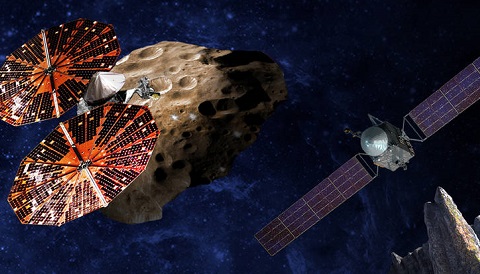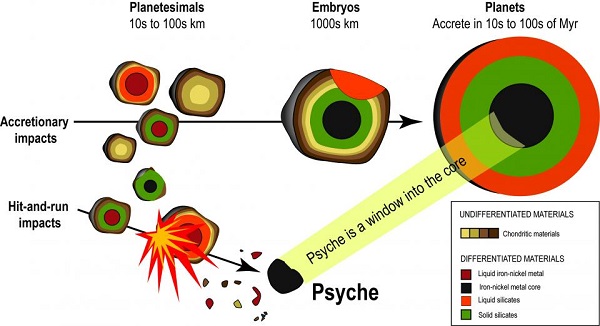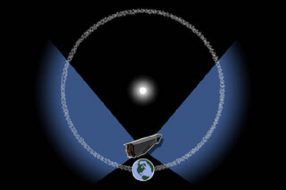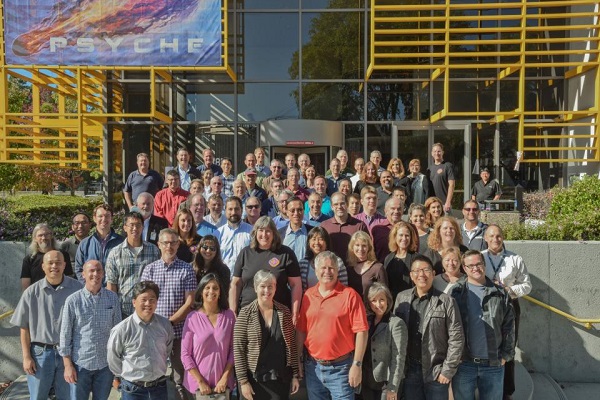Two new asteroid missions, named Lucy and Psyche, will visit eight new worlds in the coming decade.

NASA/SwRI/SSL/Peter Rubin
Last week, NASA announced two new missions set to explore the earliest remnants of the solar system: asteroid 16 Psyche and Jupiter's Trojan asteroids. The two are part of NASA's Discovery program, and were selected from five finalists, which also included the Deep Atmosphere Venus Investigation of Noble gases, Chemistry and Imaging (DAVINCI) and the Venus Emissivity, Radio Science, InSAR, Topography, and Spectroscopy mission (VERITAS) spacecraft. NASA's Near Earth Object Camera (NEOCam) also got the go-ahead.
Lucy launches in 2021, headed to Jupiter's Trojan asteroids, and the Psyche mission launches in 2023. No rocket carrier has been named as of yet. Lucy and Psyche were final selections from 27 initial submissions given to NASA in 2014.
The Psyche explorer will arrive at its destination in 2028 for a two-year primary mission. The payload for the Psyche mission is still under discussion, but will most likely include a magnetometer, neutron and gamma ray spectrometer, multispectral imager, and a radio instrument that will measure the world's gravity field. The mission will most likely earn a formal name as the launch date draws near.
Psyche: A “Very Metal” World
Astronomers have known for some time now that 16 Psyche is a strange world. Discovered by Italian astronomer Annibale de Gasparis on March 17, 1852, later radar observations of 16 Psyche's gravitational perturbations on other asteroids suggest that the 158-mile (254-km) world is actually a large naked metallic core, perhaps a remnant of a planet that never was. It's quite possible that 16 Psyche has shards of pure metal jutting out of its surface.
Psyche: Journey to a Metal World from School of Earth & Space on Vimeo.
Researchers have pushed for a mission like 16 Psyche for some time. Expect the unexpected on arrival. Is the metallic world a core of an early planet that was so badly battered early on in the formation of the solar system that it lost its rocky exterior? Did it “freeze” in its present state from the inside out, or the outside in? Did it ever create its own magnetic dynamo, like the Earth's core does today?

Arizona State University
“We'll learn what elements early cores contributed to growing planets,” says Lindy Elkins-Tanton (Lucy Principal Investigator, Arizona State University). “It's the only way humans will ever visit a core, and see a core-mantle boundary.” If a record of a frozen magnetic field is in fact detected, it would also stand as the first in situ measurement of an asteroid's magnetic field by a spacecraft.
Lucy: Asteroid Adventures
Named after the fossilized hominid who walked in eastern Africa 3.2 million years ago, the Lucy mission will visit several Trojan asteroids starting in 2027.
Trojan asteroids occupy two of the stable Lagrange points located 60 degrees ahead and behind a planet, in this case Jupiter, in its orbit. En route to Jupiter's orbit, in April 2025, Lucy will visit the main belt asteroid 52246 Donaldjohanson (named after the fossil Lucy's discoverer). Then Lucy will head to Jupiter's L4 (ahead) point to explore four worlds before reaching its final destination: binary Trojan 617 Patroclus/Menoetius in March 2033 located at the L5 (behind) point. (The asteroids captured at Jupiter's Lagrange points are named after heroes from the Trojan War, with L4 members named after the Greek camp and L5 asteroids named after the Trojan camp.)
It's unclear at this point if Lucy will, like Juno, employ solar panels instead of a plutonium-fueled Radio Thermoelectric Generator RTG, or if it will use Dawn's proven method of ion engine propulsion to visit multiple targets.
Update: According to Hal Levison (Southwest Research Institute), Lucy will employ tradition chemical propulsion and, like Juno, use solar panels for power.

Southwest Research Institute
Lucy will be the first mission to a Trojan asteroid. “This is a unique opportunity,” said Harold F. Levison, (Southwest Research Institute) in a recent press release. “Because the Trojans are remnants of the primordial material that formed the outer planets, they hold vital clues to deciphering the history of the solar system.”
“Trojans hold the key to unlocking the formation and early evolution of the giant planets,” says Hal Levison (Southwest Research Institute). “They hold clues to both the physical environment that existed at the locations where they formed, and the planetary dynamical evolution that led to them becoming trapped Trojans.” No other solar system population can give us such vital key insights to early planetary formation.
As for instruments, Lucy will fly a newer version of the OSIRIS-REx Thermal Emission Spectrometer (OTES) instrument carried by OSIRIS-REx, as well as the the RALPH and LORRI instruments used aboard New Horizons.

NASA/JPL-Caltech
The third selection, NEOCam will head for Earth's L1 Lagrange point 1 million km (621,000 miles) sunward. NEOCam is expected to reveal ten times the asteroids currently known. As with previous surveys, expect NEOCam to find more comets and up the game of professional automated versus amateur hunters . . . maybe amateurs need to launch their own space telescope?
Looking at the 2020s
Jupiter's intriguing, ice-shrouded moon, Europa, also beckons. In 2015, Congress granted NASA $175 million dollars to begin developing a mission to Europa, though NASA's 2017 budget request includes just under $50 million dollars for the effort. It's unclear at this point, but at current expenditure levels a Europa mission may not leave the pad until the late 2020s. Such a mission would orbit Jupiter and make multiple close flybys of Europa in an effort to characterize its interior.
It appears that NASA isn't putting all its eggs in one basket with its recent emphasis on low-cost missions. NASA typically selects three types of missions: Flagship missions (like Cassini), New Frontiers missions (such as New Horizons and Juno) and Discovery-class missions. Low-cost Discovery missions are capped at $450 million dollars, not including the launch vehicle. Discovery-class alumni include NASA's Mercury Messenger and Dawn, which made historic visits to asteroid 1 Ceres and 4 Vesta. With a lower cost, such missions are less attractive targets for cancellation, especially in this time of financial uncertainty for NASA as we transition between administrations. While some planetary scientists are disappointed that NASA is launching yet more low-cost asteroid missions — perhaps at the expense of visiting larger worlds — it does seem to be a prudent move.

Arizona State University
“The selected investigations have the potential to reveal much about the formation of our solar system and its dynamic processes,” says John Grunsfeld (NASA Science Mission Directorate) in a 2015 press release. “It's an incredible time for science, and NASA is leading the way.”
Get set to fill in a few more tiny corners of terra incognita on the map of the solar system and explore exotic worlds in the coming decade.
 0
0









Comments
You must be logged in to post a comment.